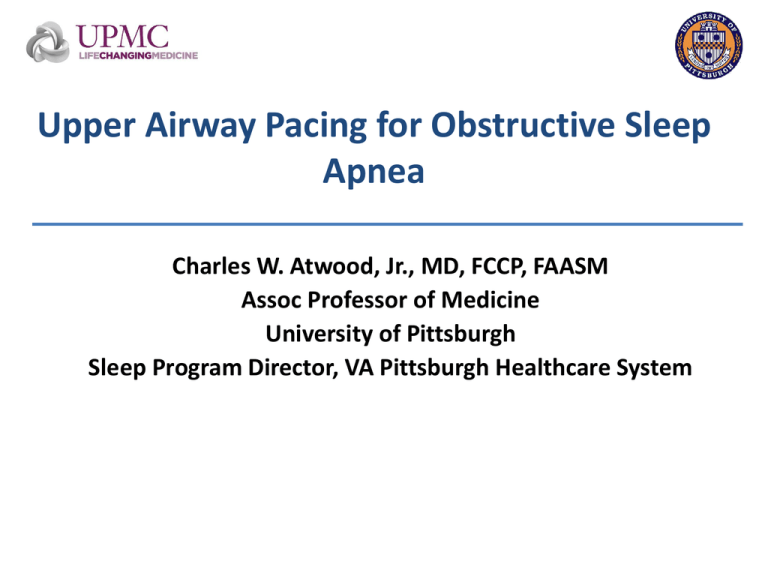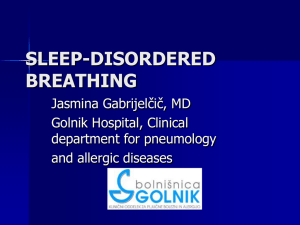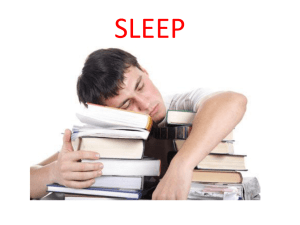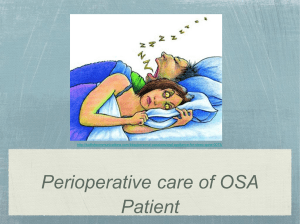
Upper Airway Pacing for Obstructive Sleep
Apnea
Charles W. Atwood, Jr., MD, FCCP, FAASM
Assoc Professor of Medicine
University of Pittsburgh
Sleep Program Director, VA Pittsburgh Healthcare System
Disclosure: Charles W. Atwood, Jr., MD
Research Support
• Federal
– NIH, NIDDK - OSA
– Dept of Defense – Lung cancer
• Industry
– Research Grant Philips-Respironics, Inc.
– Forest Research Institute
• Industry advisory
- Philips-Respironics
- Carecore National
Outline
•
•
•
•
Background
Upper Airway Stimulation
STAR Trial
Conclusions
Pathogenesis of Obstructive Sleep Apnea
Promotion of Airway Collapse
Negative pressure on
inspiration
• Extralumenal positive
Pressure
• Fat Deposition
• Small mandible
Promotion of Airway Patency
Pharyngeal dilator
Muscle contraction
(genioglossus)
Lung volume
(longitudinal traction)
Risk Mediated by a: Gene (Obesity, Craniofacial Structure, Respiratory Control
/ Environment (Obesity) Interaction
AJRCCM 2005 172:1363–1370
Sleep Disordered Breathing and Mortality: Eighteen-Year Follow-up of the
Wisconsin Sleep Cohort (n = 1396)
• SDB, irrespective of EDS, was associated with increased mortality.
• The striking high CV mortality risk in untreated severe SDB, suggests that
SDB Rx should not be contingent on daytime sleepiness symptoms
Sleep 2008 31:1071-78
Increased Prevalence of Sleep-Disordered Breathing
in Adults
• The current prevalence estimates of moderate to
severe sleep-disordered breathing (apnea-hypopnea
index, measured as events/hour, ≥15) are:
–
–
–
–
10% (95% CI: 7, 12) among 30–49-year-old men
17% (95% CI: 15, 21) among 50–70-year-old men
3% (95% CI: 2, 4) among 30–49-year-old women
9% (95% CI: 7, 11) among 50–70 year-old women
• These estimated prevalence rates represent
substantial increases over the last 2 decades - relative
increases of between 14% and 55% depending on the
subgroup
Am J Epidemiol. 2013;177(9):1006–1014
OSA and Cardiovascular Disease
• Primary HTN: 35% prevalence
• Drug-resistant HTN: 65 to 80% prevalence
– Most common secondary cause
•
•
•
•
Coronary Artery Disease: 30% prevalence
Heart failure: 21-37% prevalence
Atrial Fibrillation: OSA present 5 X more likely
Stroke: 60% prevalence
Circulation 2012;126:1495-1510
Long-term cardiovascular outcomes in men with OSA
Months
Cumulative Incidence of Non-fatal CV Events
Cumulative Incidence of Fatal CV Events
AIM: Observational study to compare incidence of fatal and non-fatal cardiovascular
events in simple snorers, patients with untreated OSA, patients treated with CPAP,
and healthy men recruited from the general population.
Design: Prospective observational cohort. 264 healthy men, 377 simple snorers, 403
with untreated mild-moderate OSA (AHI 5-30), 235 with untreated severe OSA (AHI > 30),
and 372 with OSA and treated with CPAP
Conclusion: In men, severe OSA significantly increases
the risk of fatal and non-fatal cardiovascular events.
.
CPAP treatment reduces this risk.
Months
Lancet 2005
365: 1046–53
CPAP Therapy and Adherence
PAP therapy when used consistently results in decreased daytime sleepiness*,
improved HRQOL, and decreased vascular risk.
Recent studies of CPAP therapy investigated adherence:
• APPLES Study – largest RCT in sleep medicine to date (1,516 subjects
enrolled) and CPAP adherence rate was 39% at 6-months use of CPAP
therapy (174 of 443)
• Home PAP Study – Evaluation of standard OSA care vs. home-base
diagnostics and titration. Results of 3-month follow-up: CPAP adherence
was 39% (Lab titration); CPAP adherence was 50% (Home titration)
Conclusion:
• CPAP is first-line therapy and effective when consistently used by OSA
patients.
• Alternative therapy options for moderate or severe OSA patients who are
nonadherent to PAP are desirable
OSA Value of Selected Treatment Options
• Darker more valuable.
Snoring
Mild Sleep Apnea
Moderate or Severe
Sleep Apnea
Weight loss
Nasal decongestant
Positional therapy
Surgery (adults)
Surgery (children)
Oral appliance
PAP
Only Positive Airway Pressure (PAP) and Surgery indicated for
patients with Moderate or Severe OSA
http://www.sleepapnea.org/diagnosis-andtreatment/treatment-options.html
Upper Airway
Stimulation therapy
treatment indication
Outline
•
•
•
•
Background
Upper Airway Stimulation
STAR Trial
Conclusions
The Inspire System: Built on a proven, commercial
grade technology platform
Stimulation Lead
- Self sizing cuff
- Multiple stimulation vectors
Implanted Pulse Generator (IPG)
- 6-8 year projected longevity
Effort Sensor
- Secure, stable location
- Direct measurement of ventilatory effort
- Short surgical tunnel
Upper Airway Anatomy & Stimulation Site
Superior Longitudinal
Styloglossus (SG)
Hyoglossus (HG)
Inferior Longitudinal
Stimulation Site:
Medial branch of
the hypoglossal
nerve, activates
only protrusors
(genioglossus,
geniohyoid), distal
to retractors
(styloglossus and
hyoglossus)
Superior root of
ansa cervicalis
Thyrohyoid
Geniohyoid (GH)
Stimulation Site
Hypoglossal Nerve (XII)
Genioglossus (GG)
Upper Airway Stimulation
• No airway anatomy
alteration
• Works with patients
physiology
• Standardized implant
technique
• Fast post op recovery
Patient Programmer
• Turn therapy
ON/OFF
• Adjust amplitude
Device Programmer
• Adjust Therapy
Parameters
• Bluetooth enables
remote adjustments
during titration studies
in the sleep lab
Basic Therapy Parameters
Sensor Signal
Onset
Expiratory
Inspiratory
Offset
Stimulating Pulses
• Amplitude (V) – primary
stimulation strength
adjustment
• Rate (Hz) – default 33 Hz
• Pulse Width (µsec)–
default 90 µsec
Upper Airway Stimulation advances tongue
to open airway
Airway Obstructed
STIMULATION OFF
Tongue base
Tongue Advanced
STIMULATION ON
Epiglottis
Tongue base
Observed during sleep
endoscopy
Tongue base advancement with
stimulation
Effect of stimulation on the Retropalatal and Retrolingual
airway area between awake endoscopy and DISE
Eur Respir J 2014; in press
Increases in retropalatal and retrolingual area comparing no
stimulation with progressively higher levels of stimulation during
DISE
First sensation
Bulk movement Titrated therapeutic Sub-discomfort
Retrolingual
Retropalatal
No stimulation
Eur Respir J 2014; in press
PSG: Effect of Stimulation
EEG
EMG
Nasal
Pressure
Thermo
Chest
Abdomen
SpO2
30 seconds
Therapy OFF
Therapy ON
In-lab PSG Titration Algorithm
Arousal Threshold
Amplitude (volts)
Therapeutic Amplitude Range
≥ 30 minutes in the patient’s preferred sleep
position with minimum occurrence of events,
preferably with REM sleep observed
Reduce amplitude by 0.1 to
0.2 volts if stimulation causes
persistent arousals or is
poorly tolerated
≥ 10 min
Start:
0.2 V below
Functional Threshold
Time (minutes)
Increase amplitude by 0.1 to
0.2 volts if ≥ 5 obstructive
apneas or hypopneas or loud,
unambiguous snoring
*Adapted from current practice guidelines established for CPAP titration by the American
Academy of Sleep Medicine, ref: Journal of Clinical Sleep Medicine, Vol. 4, No 2, 2008 20
Clinical Trial Experience
Proof of Principle Trial
Feasibility Trial
• 8 patients
4 Centers
• 34 patients
8 Centers
• Completed in 2001
• Completed in 2010
• Demonstrated therapy concept
• Demonstrated safety and patient
selection
Reference:
Arch Otolaryngol Head
Neck Surg 2001
127:1216-1223
References:
1. Operative technique in
otolaryngology-head and neck
surgery. 2012 23(3): 227-33
2. Journal of Clinical Sleep Medicine
2013 9 (5) 433-438
3. The Laryngoscope 2012 122(7): 162633
Examples collapse at the level of the
palate during DISE
Anteroposterior collapse
Concentric collapse
JCSM 2013 9 (5) 433-438
Inspire UAS effect during DISE
Palate
Therapy OFF
Palate
Therapy ON
P
P
Reference: 2 slices
R
L
Palate
Posterior
oropharyngeal
wall
R
L
Posterior Uvula
Tongue-Base
Tongue Base
Therapy OFF
Tongue Base
Therapy ON
P
P
Epiglottis
R
R
L
Lingual Tonsils
L
Outline
•
•
•
•
Background
Upper Airway Stimulation
STAR Trial
Conclusions
Stimulation Therapy for Apnea Reduction
(STAR Trial) ClinicalTrials.gov NCT01161420
Hypothesis: Unilateral Stimulation of the
Hypoglossal Nerve during sleep will safely and
effectively treat Obstructive Sleep Apnea
NEJM 2014 370:139-49
Outcome Measures: Baseline vs. 12-Months
• Co-Primary
– Apnea Hypopnea Index
– Oxygen desaturation index (ODI4%)
• Secondary
– Epworth Sleepiness Scale
– Functional Outcomes of Sleep Questionnaire
– SaO2 < 90%
NEJM 2014 370:139-49
Methods I
• Prospective, multicenter trial with randomized
therapy withdrawal arm in participants with
moderate to severe OSA who had failed or had
not tolerated CPAP.
• All underwent a screening polysomnographic
(PSG) study, surgical consultation, and druginduced sedation endoscopy (DISE).
• Participants without complete concentric
collapse at the retropalatal airway received an
implanted neurostimulator
NEJM 2014 370:139-49
Inclusion Criteria
• AHI between 20 and 50
• Have failed or have not tolerated CPAP
• Central and mixed sleep apnea accounted for
< 25% of all AHI events
• Absence of significant apnea when sleeping
in a non-supine position (AHInon-supine > 10)
NEJM 2014 370:139-49
28
Exclusion Criteria
•
•
•
•
•
BMI > 32
Neuromuscular diseases
Severe Co-Morbid Cardiopulmonary Disease
Other chronic sleep disorders
Complete concentric collapse at the level of
soft palate during drug-induced sedation
endoscopy (DISE)
NEJM 2014 370:139-49
29
Examples collapse at the level of the
palate during DISE
Anteroposterior collapse
Concentric collapse
JCSM 2013 9 (5) 433-438
Methods II
• Participants were followed for 12 months to
assess efficacy and adverse events.
• PSG (AHI and ODI)
• Quality of life measures
– Epworth Sleepiness Scale (ESS)
– Functional Outcomes of Sleep
Questionnaire (FOSQ)
• Responders after 12 months of continuous
therapy were randomized to one week of
therapy suspension (OFF) vs. therapy
maintenance (ON) and evaluated with PSG.
NEJM 2014 370:139-49
Consort Flow Chart
Enrollment
N = 929
Screening
Enrollment Exclusions (205)
•
•
•
•
•
Did not meet inclusion/exclusion criteria (108, 13.4%)
Participant withdrawal of consent (60, 7.5%)
Study implant limit complete – Participant withdrawn (21, 2.6%)
Participants lost to follow-up prior to implant (13, 1.6%)
Other withdrawals prior to implant (3, 0.4%)
N = 724
N = 126
Implant
Screen Exclusions (598)
N = 126
PSG
•
•
•
•
AHI < 20 (347, 43.2%)
AHI > 50 (87, 10.8%)
Central sleep apnea: (50, 6.2%)
Positional OSA: (45, 5.6%)
•
•
Tonsil size 3 or 4 (4, 0.5%)
Other unfavorable anatomy
(9,1.1%)
•
Complete concentric palatal
collapse (54, 6.7%);
Others (2, 2.5%)
1 month visit
Surgeon
Consultation
N = 126
2,3,6, & 9 month
visits
Sleep
Endoscopy
N = 126
12 month visit
N = 124
•
•
•
1 unrelated participant death
1 participant with elective device removal
NEJM 2014 370:139-49
Baseline Characteristics of the Study Population (N = 126)
Characteristics
Mean ± SD or N (%)
Age, year
54.5 ± 10.2
Male sex, no. (%)
83%
Caucasian race, no. (%)
97%
Body Mass Index, kg/m2
28.4 ± 2.6
Neck size, cm
41.2 ± 3.2
Systolic BP, mmHg
128.7 ±16.1
Diastolic BP, mmHg
81.5 ± 9.7
Hypertension, no. (%)
38%
Diabetes
9%
Asthma
5%
Congestive heart failure
2%
Prior UPPP, no. (%)
18%
NEJM 2014 370:139-49
Primary Outcome Measures: AHI and ODI (n = 124)
AHI
40
ODI
40
p < 0.0001
35
35
30
p < 0.0001
29.3
30
25.4
25
25
20
20
15
15
9.0
10
10
5
5
0
0
Baseline
Month-12
• 68% reduction in AHI from
baseline to Month-12
*Median and error bar in standard error
7.4
Baseline
Month-12
• 70% reduction in ODI from
baseline to Month-12
NEJM 2014 370:139-49
Secondary Outcome Measures: FOSQ & ESS (n = 123)
ESS Scale
14
12
FOSQ Score
20
p < 0.0001
p < 0.0001
19
11.0
18.2
18
10
17
16
8
6.0
6
15
14.6
14
4
13
12
2
Baseline
Month-12
Baseline
Month-12
*Median and error bar in standard error
NEJM 2014 370:139-49
Secondary Outcome Measure: SaO2 < 90%
p < 0.05
Medain % of TST SaO2<90%
6.0
5.4
5.0
4.0
3.0
2.0
1.0
1.0
0.0
Basline
M12
NEJM 2014 370:139-49
Randomized Controlled Therapy Withdrawal
Maintenance Group (N=23)
Withdrawal Group (N=23)
35
30
AHI
25
p < 0.0001
31.3
30.1
25.8
20
p = n.s.
15
10
5
7.2
7.6
8.9
0
Baseline
*mean and error bar in standard error
Month-12
RCT
NEJM 2014 370:139-49
Relevant Adverse Events
• Serious: Device related
– 1% Device revision
• Non Serious: Procedure related
– ~ 25% Pain (minimal, most did not require narcotics substantially less than UPPP)
• Non-Serious: Device related
– ~ 33% Tongue discomfort / abrasion (time limited)
– 1% Mild or Mod Infection (cellulitis)
* One Death Unrelated to the Trial
NEJM 2014 370:139-49
Adherence Data
• After 12 months follow up of 126 implanted participants, 124
participants (98%) remained active users of UAS therapy.
• One participant died unexpectedly due to an unrelated cause, and
one participant requested a device removal for personal reasons.
• Based on self reports from 123 participants at 12 months, 86%
(106 of 123) used the device daily and 93% (115 of 123) used the
device at least 5 days a week.
• The UAS device registers the cumulative hours of stimulating
pulses duration since last device interrogation. At the 12-month
visit, the average stimulation pulses time was 2.6 hours per night.
• The stimulating pulses were not delivered continuously during
sleep, and were only delivered during the late expiratory and
inspiratory phases of respiration.
NEJM 2014 370:139-49
Measurement of Use of Therapy
Exhale
Sensor Signal
Inhale
5 second
Stimulating Pulses
NEJM 2014 370:139-49
Upper Airway Stimulation effect on Sleep
Baseline
N = 126
Sleep
Time, min
Mean(SD)
364.8
(68.0)
N1 Sleep 42.0 (21.0)
234.5
N2 Sleep
(56.0)
N3 Sleep 31.0 (27.6)
REM Sleep 57.3 (27.4)
12 Month
N = 124
% of Total
Sleep
Total Sleep
Arousal
Index
11.5
64.3
8.5
15.7
Mean(SD)
333.7
(69.3)
31.1 (15.9)
214.3
(60.2)
36.0 (31.5)
52.2 (33.8)
% of Total
Sleep
P value
<0.0001
9.3
<0.0001
64.2
0.0002
10.8
15.6
0.03
0.08
Median (IQR)
Median (IQR)
28.9 (20.5, 40.8)
14.8 (10.3, 24.8)
<0.0001
NEJM 2014 370:139-49
REM vs. NREM Sleep
Outcome
Measures
Baseline
Mean (SD), N
Median (IQR)
12 Month
Mean (SD), N
Median (IQR)
Change (BL12M)
Mean(SD), N
Median (IQR)
P Value
AHI, REM
28.9 (17.4), 126 14.7 (16.1), 124 13.8 (19.2), 124
<0.0001
28.4 (16.4, 39.3) 10.0 (3.0, 21.4) 13.8 (3.6, 25.2)
AHI, NREM
32.3 (12.6), 126 15.3 (16.8), 124 16.7 (17.4), 124
<0.0001
30.5 (22.9, 39.5) 8.7 (3.6, 21.8) 18.2 (8.7, 27.7)
NEJM 2014 370:139-49
Other Outcome Measures
Outcome
Measures
Baseline
Mean (SD), N
12 Month
Mean (SD), N
Change (BL-12M)
Mean(SD), N
P Value
Heart Rate
74.8 (10.7), 126
75.0 (10.4), 124
-0.6 (11.7), 124
0.56
128.7 (16.1), 126 126.4 (13.9), 124
2.5 (16.3), 124
0.12
Systolic Blood
Pressure
Diastolic Blood
Pressure
81.5 (9.7), 126
79.3 (9.5), 124
2.3 (10.6), 122
0.02
BMI
28.4 (2.6), 126
28.5 (2.6), 119
-0.03 (1.3), 119
0.78
NEJM 2014 370:139-49
Outline
•
•
•
•
Background
Upper Airway Stimulation
STAR Trial
Conclusions
Conclusions
• The STAR Pivotal Trial provided definitive
evidence that upper airway stimulation is
safe and effective in participants with
moderate to severe OSA
• Upper Airway Stimulation can play a
significant role in the management of
properly selected “at risk” patients who do
not accept or adhere to CPAP therapy
Acknowledgements
STAR TRIAL CENTERS
St Lucas Andreas - Netherlands
North Memorial - Minneapolis
UPMC
University of South Florida
St Petersburg Sleep Disorders Center
St Cloud ENT - Minnesota
University of Mannheim - Germany
University of Cincinnati
Case Western
Medical University of South Carolina
Medical College of Wisconsin
UZA - Belgium
Borgess Kalamazoo
Intersom Koln - Germany
California Sleep - Palo Alto
Swedish - Seattle
Advanced ENT - Atlanta
Wayne State - Detroit
Sleep Medicine Associates - Dallas
CHU de Bordeaux
Foch Paris
Bethanien Solingen - Germany
STAR TRIAL INVESTIGATORS
DeVries
Cornelius, Froymovich
Strollo, Soose, Atwood
Padhya, Anderson
Feldman
Hanson, Payne
Maurer
Steward, Surdulescu
Strohl, Baskin
Gillespie
Woodson
VanderVeken, Verbracken, Van de Heyning
Goetting, Szeles
Knaack, Mockel
Roberson
Stolz, Yang
Mickelson
Badr, Lin
Jamieson, Williams
Philip, Monteyrol
Chabolle, Blumen, Hausser-Hauw
Randerath, Hohenhorst
NATURE 2010 463: 258-259
Thank You
University of Pittsburgh / CTSI / Clinical + Translational Science Institute







